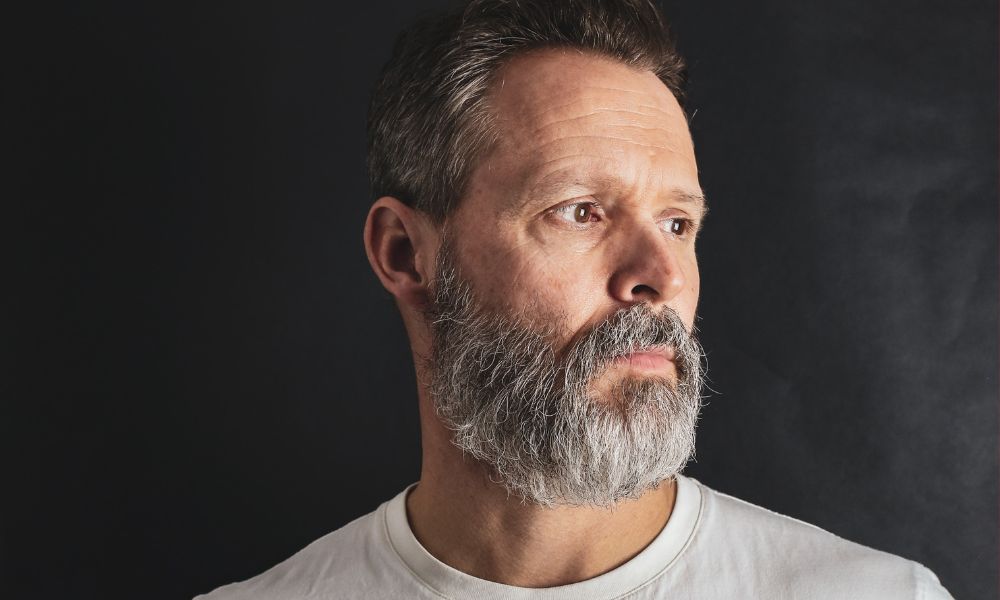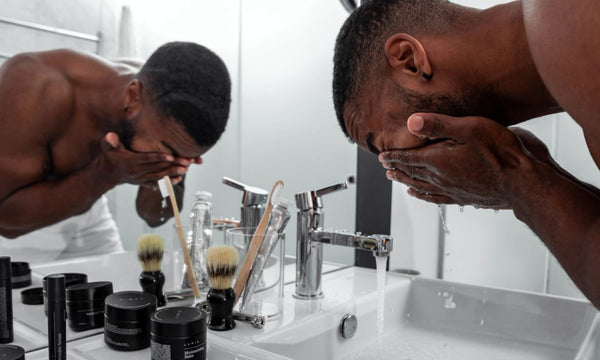Success! TRAVEL24 has been applied to your cart.
Place your order before midnight on Monday, May 27 to receive a free travel size serum. Limited to first 500 orders.

Beard Dandruff and Seborrheic Dermatitis: Causes, Prevention, & Natural Remedies
We've all heard about scalp dandruff. And while it's a common skin condition, your scalp isn't the only part of your body where you may notice white flakes and itching. Men with facial hair may also experience beard dandruff.
If the skin under your facial hair feels itchy and has begun flaking, you could be looking at a case of beard dandruff. It's more common than you think, just not often discussed.
Shaving your beard would be one of the best ways to eliminate the problem. But, of course, your beard may be a prominent feature of your look and a great confidence boost; hence, a clean shave might not be the most favorable option.
The good news is that there are other natural methods to tackle beard dandruff that don't require you to get rid of your facial hair!
In this article, we'll explore the causes of beard dandruff and how you can manage this skin condition via all-natural methods.
Table of Contents
What Causes Beard Dandruff?
The most common cause of beard dandruff is seborrheic dermatitis. Seborrheic dermatitis is a non-contagious skin condition that primarily affects areas of your skin rich in sebaceous glands. These glands secrete sebum, an oily substance [1].
Sebaceous gland-rich regions include your face, scalp, and chest. These areas are where you'd typically observe symptoms of seborrheic dermatitis.
Some symptoms you may notice include itch, inflammation, flaky skin, and skin irritation [1].
Another cause of beard dandruff may just be dry skin. If you only notice flaky skin without the additional redness, itchiness, or irritation, then dry skin is likely the culprit.
Additionally, natural beard oil and the accumulation of dead skin cells may also be another cause, especially if your facial hair isn't cleaned and groomed often enough.
If your skin cells regenerate quicker than normal, this could lead to a greater accumulation of dead skin cells and the formation of dandruff flakes.
What Causes Seborrheic Dermatitis, Then?
So now that we've established seborrheic dermatitis as the most common cause of beard dandruff, the focus now redirects to the causes of seborrheic dermatitis.
So, what leads to seborrheic dermatitis, then?
Well, scientists are still unsure what the exact cause of seborrheic dermatitis is. But a possible culprit has been highlighted. It's a fungus called Malassezia, which feeds on sebum.
This fungus typically resides on your skin, staying out of any trouble. However, some research suggests that the rapid growth of Malassezia on the skin can lead to the development of seborrheic dermatitis [2].
As Malassezia consumes the sebum on your skin, it breaks it down into fatty acids such as oleic acid, which can irritate the skin and cause an inflammatory response in some people [3].
Hence, the Malassezia fungus may be responsible for the white flakes, itching, and red skin under your beard or facial hair.
While the Malassezia fungus is thought to be a prominent cause of seborrheic dermatitis, some other factors may also aggravate your condition or trigger a flare-up. They are as follows [4]:-
-
Very hot or cold weather
-
Feeling stressed
-
Being deprived of sleep
-
Certain cosmetic products
-
Exposure to sun
-
Excess sweat

This is why you might notice dandruff flare-ups during certain times, which then disappear as you shift through different environments and seasons of your life.
How To Prevent Beard Dandruff
There are various methods of preventing and reducing beard dandruff. Let's explore them!
Try out an antifungal shampoo.
There are various over-the-counter antifungal shampoos that you can purchase. The main ingredient to look out for is ketoconazole.
Research has proven ketoconazole shampoo to be effective in tackling seborrheic dermatitis and dandruff [5].
You may start with a lower concentration (i.e.,1% ketoconazole shampoo). Higher concentrations and stronger doses typically require a prescription from your doctor.
Since ketoconazole has antifungal properties, it can kill off the fungus present around your facial hair region, alleviating symptoms of beard dandruff.
Some shampoos may contain other antifungal agents, such as pyrithione zinc and selenium sulfide.
Start using the medicated shampoo a few minutes before you take your shower. Massage the shampoo into your beard, giving it enough time to seep in and reach the skin beneath your beard hair. You can then thoroughly wash it off when you take your shower.
Maintain good beard hygiene.

Fortunately, the general regimen for keeping your chin fuzz well-maintained is relatively simple.
Here are some practical ways to maintain a healthy beard and keep skin problems at bay:-
-
Exfoliate your skin.
-
Exfoliation helps to remove excess dead skin cells, including those that may contribute to beard dandruff.
-
You may opt for a beard exfoliator scrub or a soft-bristled beard brush to exfoliate your beard. Gently massage your beard using either of those tools without scrubbing too hard.
-
-
Use the right shampoo.
-
Shampoos for your hair may be a little too harsh to use on your face, especially if you notice dry skin, skin irritation, or skin flakes.
-
A safer option would be a beard shampoo and conditioner designed specifically for this purpose. Alternatively, you could opt for a medicated shampoo containing an antifungal agent.
-
-
Keep your beard well-moisturized.
-
A beard moisturizer usually refers to beard oil, balm, or cream.
-
You can easily purchase beard oil off online shopping platforms, but it's best to take a careful look at the ingredients list before hitting 'add to cart.'
-
Some beard oils contain oils that feed and fuel Malassezia growth, which is a big no-no if you want to combat beard dandruff. One such oil to avoid is coconut oil.
-

Get into the groove of a healthy lifestyle.
Some lifestyle factors may also affect the risk of a seborrheic dermatitis flare-up.
For starters, a lack of sleep can aggravate your symptoms [4].
The following are a few simple ways to achieve better quality sleep at night:-
-
Cultivate a restful environment for sleep. Remove distractions and keep your room dark and at a comfortable temperature.
-
Create a regular sleep schedule and stick to it as closely as possible.
-
Limit daytime napping.
-
Watch what you eat (and drink) too near your bedtime. Being too full or hungry when heading to bed can hamper your sleep quality. And be cautious of sipping on coffee or wine too close to bedtime.
Another factor that can aggravate seborrheic dermatitis and lead to worsening beard dandruff is emotional stress [4].
It may take some proactive experimentation to find an effective way to cope with stress. In general, many individuals find that one or more of the following methods help them better manage stress in a healthy and sustainable manner:-
-
Keep active. Physical exercise is a core pillar to better physical, emotional, and mental wellness. Add nature to the mix for an extra boost.
-
Prioritize self-care. Take a hot bath, visit the farmer's market, make kombucha tea, journal, read a book, or enjoy a massage.
-
Try out relaxation techniques, deep breathing, yoga, or meditation.
-
Make room and time for your hobbies.
-
Prioritize getting enough quality sleep at night.

The effects of a healthier and more balanced lifestyle may not translate immediately to happier skin.
But in the long run, such practices may help to better foster skin healing, prevent symptom flare-ups, and reduce the appearance of beard dandruff.
Natural Management Options for Beard Dandruff and Seborrheic Dermatitis
Natural remedies have long been viewed as favorable management options for skin problems. The fact is that these remedies may not work for everyone and may take some time to display significant benefits.
That said, they've become popular for a couple of reasons. Some people may have experienced side effects from conventional dandruff treatment, while others are keen on combining the two to amplify their benefits.
Before using any of these natural remedies, ensure you perform a skin patch test.
Here are some natural remedies that may work for beard dandruff:-
Tea tree oil
Tea tree oil has been shown to be effective for facial seborrheic dermatitis. According to research, it helps to minimize scaling, itching, redness, and the formation of greasy crusts associated with seborrheic dermatitis [6].
Before using tea tree oil for beard dandruff, ensure you dilute it in water or carrier oil. Alternatively, you may look for a shampoo or facial product containing tea tree oil.
MCT oil
While there haven't been many research studies on the efficacy of MCT oil for dandruff or seborrheic dermatitis, anecdotal reports on its benefits are promising. MCT is one of the safest oils that are less likely to fuel the growth of the Malassezia fungus.
You may massage a small amount of MCT oil directly into your beard. Alternatively, you can mix it with your beard shampoo.
Manuka honey

Another at-home remedy involves harnessing the natural anti-inflammatory and antifungal properties of honey.
Research has revealed that honey may combat itching and scaling of the skin resulting from dandruff and seborrheic dermatitis. Researchers also noted that honey has preventative benefits that lower the risk of recurring flare-ups [7].
It's best to opt for medical-grade honey, which you can dilute with a bit of water for application.
In the study, participants left honey on the affected areas for about three hours each day [7].
You can do the same or leave it on overnight. But you risk attracting unwanted visitors at night (like ants) if you choose the latter.
Apple cider vinegar
Some research suggests that apple cider vinegar has antifungal effects and can help combat the growth of the Malassezia fungus [8].
Though more studies are required to prove the efficacy of apple cider vinegar in tackling dandruff, anecdotal evidence looks promising.
Keep in mind that you should not use undiluted apple cider vinegar directly on your skin. A typical ratio used is one part vinegar to four parts water. Apply the mixture to the affected areas, and leave it on for a few minutes before rinsing it off.
Aloe vera

Aloe vera is a popular ingredient found in various facial products, and there's a good reason why; aloe vera possesses impressive anti-inflammatory and moisturizing properties.
One study found that aloe vera extract helped tackle itchy skin, scaling, and flaking resulting from seborrheic dermatitis [9].
You can easily purchase aloe vera in various creams, gels, and products online.
Calming Seborrheic Serum
The Calming Seborrheic Serum consists of a blend of holistic ingredients that work together to calm irritated skin.
The serum reduces redness, itch, and flaking by clearing the Malassezia fungus while keeping your skin well-nourished and hydrated.
The Calming Seborrheic Serum is safe to use on the face, scalp, and body. No harsh or hard-to-pronounce chemicals are included in the mix, as the serum relies on humble yet powerful ingredients that help relieve moody skin.
If you're nervous about trying out a new product, we've got you covered with a risk-free guarantee. We'll refund your purchase if the results don't amaze you after 60 days.
Relief awaits you; get your bottle here!




